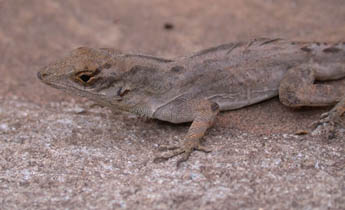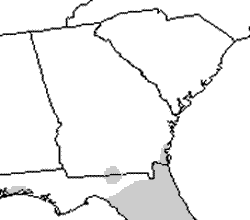Brown Anole (Anolis sagrei) – Introduced



Photos by J.D. Willson unless otherwise noted
Description: 5 – 8.5 in (12 – 21 cm). Brown anoles are brown to grayish in color, generally with whitish or yellowish patterning on the back. Males generally have an orange or red throat fan with a white edge. Although the brown anole has a shorter snout than the green anole (Anolis carolinensis), the two species are most easily distinguished by the green anole’s green or lightly patterned brown coloration and by range.
Range and Habitat: The brown anole was introduced in southern Florida from the Caribbean decades ago. Since then, this species has been slowly expanding northward and is now firmly established in some areas of coastal and southern Georgia. It is likely that this species will continue to expand its range northward in coming years. Brown anoles are generally less arboreal (living in trees) than green anoles and are usually found on the ground or in low vegetation. Brown anoles thrive in almost any habitat and are often abundant in suburban or even urban areas.
Habits: Anoles are active by day in warm weather and often bask in vegetation, occasionally charging away from a basking spot to grab and inset or chase off a rival anole. During cool weather anoles are often found hiding under tree bark, shingles, or in rotten logs. Sometimes many anoles can be found taking refuge in one spot.
Prey: Anoles eat a wide variety of insects, spiders, and other invertebrates.
Reproduction: Throughout the warm months, female brown anoles lay single, round, eggs, in moist soil or rotten wood at roughly 14 day intervals.
Abundance: Brown anoles are among the most abundant reptiles in areas where they are firmly established.
Notes: Since its introduction, the brown anole has become one of the most abundant lizards in Florida. It is uncertain how the proliferation of this species will affect native wildlife as its range expands northward.
